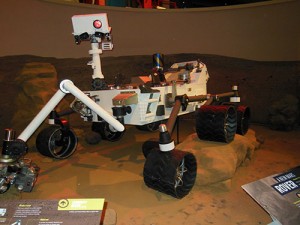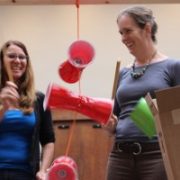Playing in New England
The New England Museum Association conference is one of my favorite events of the year. It always takes place in November – when the air is crisp and Thanksgiving is right around the corner. What could be a better time to visit New England?
This year’s conference took place in Cambridge, Massachusetts, and was the biggest to date with about 1100 participants. Even with that number, the conference feels intimate, and I was so delighted to run into so many Affiliate colleagues during the week. The theme of this year’s conference was Health and Wellness – so appropriate as museums play such a critical role in the health of their communities.
The keynote panel set the tone for the week. The panel brought together three local museum directors and two physicians, an interesting mashup that revealed all the ways that museums heal people and communities. They talked about museums being among the most trusted community resources, and places of respite and beauty, which is why people tend to flock to cultural institutions in times of crisis. The doctors for example, discussed the importance of careful looking when making a diagnosis – a skill they teach in part by taking students to museums. What a great discussion.
A few Affiliate colleagues and I got an opportunity to hang out at an amazing research center near the hotel, the Smithsonian Astrophysical Observatory [SAO]. There, a Smithsonian educator showed us the Great Refractor, built in 1847 and once the largest telescope in the United States. We all got the chance to try out the unique seat designed for looking through the telescope, an elegant 19th century solution. From the old to the new, we then visited SAO’s state-of-the art control room for studying the Sun, and “saw” it at several different temperature iterations in close to real time. It was beautiful and flaring in a way we’d never seen before.
Conference attendees also had the great fortune to visit the USS Constitution Museum for an evening reception. The Museum, an Affiliate since 2011, is a trailblazer in terms of research into family learning. They have already published the Family Learning Forum website based on research and testing on engaging exhibition techniques. The Museum is now turning its attention to programming with the same vigor, and funds from an IMLS National Leadership Grant. One
of the activities under testing asks visitors to be part of a 4-person team required to fire cannons from the USS Constitution ship, a much more difficult process than I imagined. With a blue tarp as the ocean and a print of an enemy ship on the other side, my team fired an “alka seltzer cannon” and learned about the teamwork required to be successful in those conditions. The Museum staff is refining a body of knowledge about family learning and best practices that will ultimately and undoubtedly benefit the entire museum field.
On the last day of the conference, I was honored to speak in a session with colleagues from our other New England Affiliates, Mystic Seaport and Plimoth Plantation. Titled, It CAN be all Fun and Games, we looked at Affiliate examples of incorporating games and physical activity into museum interpretation. The best part was that the directors of interpretation and education from Mystic and Plimoth brought actual games that they play on their 17th and 19th century living history sites, like skittles, Wampanoag football, stoolball, stilts, hoop games, harpoon throwing, marbles and even stilts. I was a little anxious that audience members might not want to “play” on the last day of the conference.. but I was wrong. It reminded me of an important lesson – adults also want to play and have fun like kids do. Give them an opportunity – at a conference or at a museum – and they will literally run with it.
I attended so many useful sessions and heard so many great ideas. Here’s a quick roundup of the highlights:
– Think socially responsible or responsive programming might introduce mission creep at your museum? But what if your mission wandered into a place that made you more relevant to your community?
– Think it’s hard to engage millennials (ages 21-40)? Think again. They are visiting cultural institutions in droves, and there are about 80 million of them in America right now. Don’t know how? It’s easy. Ask them. And then empower them to create the programming they want to attend at your museum themselves. For a great example, check out the Portland Museum of Art’s Contemporaries group.
– Do your public spaces achieve the magic power of 10? That is, can people find 10 things to do in your plazas, courtyards, front steps, etc.? (eat, people watch, see a performance, access wifi, meet friends, etc.) For ideas, check out the Peabody Essex Museum.
– Attending a conference is a great opportunity for a networking game. It’s super fun when it’s easy and for example, on your cell phone. The one we played at NEMA had us asking questions of each other like “have you ever lived abroad?” and snapping photos for extra points. Thanks Museum Trek.
Given the breadth, depth and richness of the conversations I attended last week, it’s abundantly clear that the museum community in New England is very healthy, and helping to make their communities amazing places to live. A big thanks to the small but mighty staff at the New England Museum Association for bringing us together and expertly facilitating such enriching dialogue. And Happy Thanksgiving to all!


































